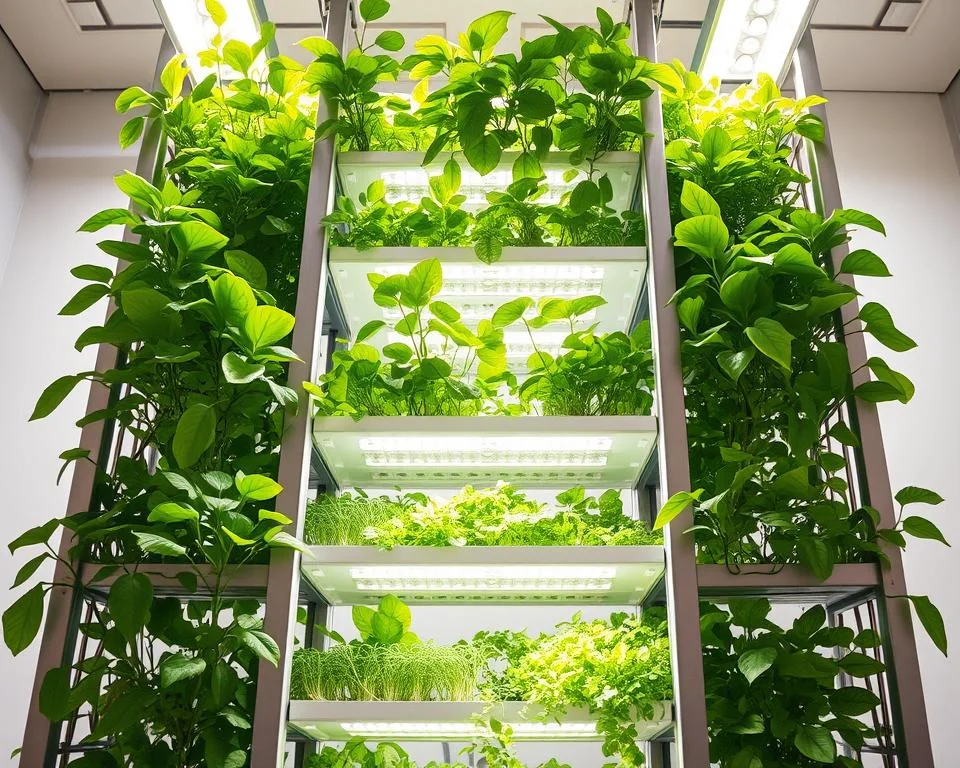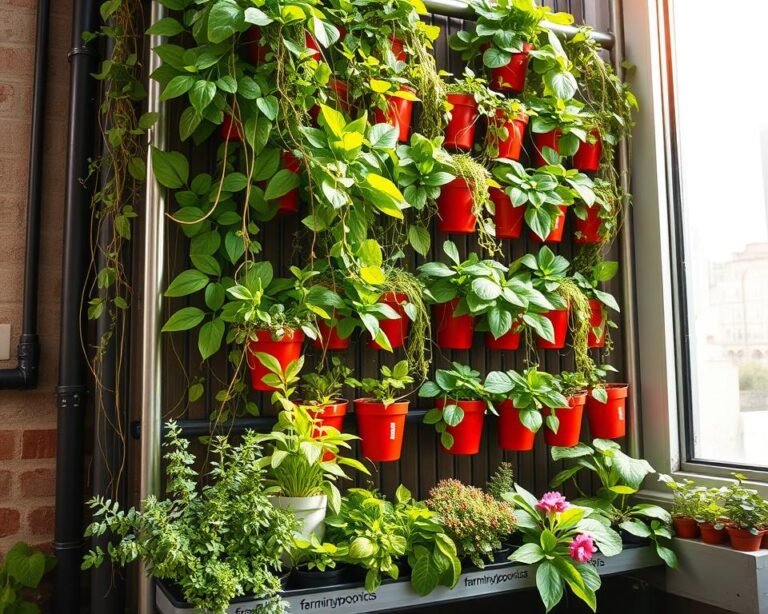Hydroponic Systems for Vertical Gardening
Imagine transforming a small city balcony into a year‑round vegetable patch. With modern hydroponic systems, you can grow fresh produce vertically—no soil required—making the most of every inch of urban space.
These systems deliver nutrients through water, giving plants exactly what they need for rapid, healthy growth. In fact, vertical hydroponic setups can use up to 90 % less water than traditional methods and speed crop production by 25–30 %.
Whether you’re an experienced gardener or a sustainability beginner, hydroponic systems offer a clean, space‑saving way to harvest crisp lettuce, fragrant herbs, and juicy tomatoes right at home—proving that soil‑free gardening is the future of urban farming.
Key Takeaways
- Hydroponic systems enable soil-free growing in compact urban spaces
- Water usage is dramatically reduced compared to traditional agriculture
- Plants grow faster with direct nutrient access
- Year-round crop production becomes possible
- Minimal pesticide use creates healthier produce
Understanding the Basics of Vertical Hydroponics
Indoor farming has changed the way we grow food. It offers new ways to solve global food problems. Vertical hydroponics is a key part of this change, making growing plants easier and more efficient.
As the world’s population grows, we have less land to farm. Vertical hydroponics is a new way to farm that’s very efficient. It can grow a lot of food in a small space:
- Uses 98% less water than traditional agriculture
- Yields 240 times more crops per square foot
- Operates independently of seasonal limitations
What Makes Hydroponic Growing Different
Hydroponic growing changes how plants get their nutrients. It gives nutrients directly to the roots. This is different from farming with soil, where it’s harder to control what plants get.
With nutrient solutions, plants get exactly what they need. This makes growing plants more predictable and successful.
Key Components of a Hydroponic System
A good hydroponic system needs a few important parts:
- Specialized growing containers
- Precise nutrient delivery mechanisms
- Controlled lighting systems
- Advanced environmental monitoring
The Science Behind Soilless Growing
“Vertical hydroponics represents the future of sustainable agriculture, transforming urban spaces into productive growing environments.”
The science of hydroponics is about how plants grow without soil. It’s about the right pH levels and oxygen for plants. This lets plants grow fast and strong without soil.
Benefits of Vertical Hydroponic Gardening
Vertical hydroponic gardening is a new way to grow food in cities. It changes how we grow food indoors, making it more sustainable and efficient.
“Vertical hydroponics is not just gardening; it’s a solution to urban food challenges.” – Agricultural Innovation Research Center
Here are the main benefits of vertical hydroponics:
- Water Conservation: Uses 98% less water than traditional farming methods
- Space Efficiency: Produces significantly more food per square foot
- Year-Round Production: Allows growing seasonal foods consistently
- Reduced Environmental Impact: Minimizes food miles and chemical usage
Your indoor vertical garden can yield amazing results. You can harvest up to 25 pounds of fresh food every 28 days. This method also cuts labor costs by about 30% compared to traditional farming.
| Metric | Vertical Hydroponic Performance |
|---|---|
| Water Usage | 98% less than traditional farming |
| Energy Efficiency | 90% less light energy consumption |
| Annual Harvest Potential | Up to 3,400 plants per system |
| Food Safety Ranking | Top 1% of food-safe environments |
For city folks looking for sustainable food, vertical hydroponics is a great option. It lets you grow fresh, healthy food right at home. This method uses less water, no soil, and fewer chemicals, showing the future of smart, green farming.
Hydroponic Systems and Their Applications
Vertical farming has changed how we grow food by using new hydroponic systems. These systems help grow more crops in small spaces. Knowing about these methods can help you pick the best one for your project.
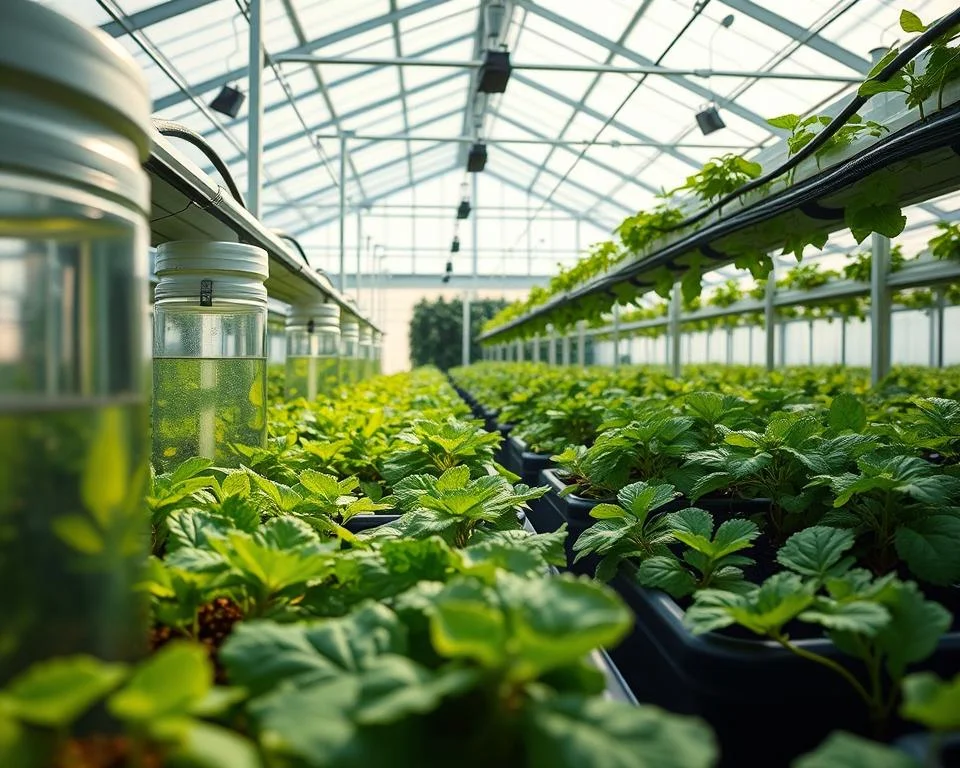
Nutrient Film Technique (NFT)
The Nutrient Film Technique is a water-saving way to farm vertically. It keeps a thin stream of nutrient solution flowing over the roots. This keeps the plants healthy and well-oxygenated. It’s great for growing light crops like lettuce and herbs.
- Minimal water consumption
- Continuous nutrient delivery
- Ideal for leafy greens
Ebb and Flow Systems
Ebb and Flow systems flood the roots with nutrients and then drain. This creates a good growing environment. Your grow lights can help by providing light when the roots are flooded.
“Precision is key in hydroponic cultivation” – Agricultural Innovation Journal
Drip Systems
Drip systems give nutrients directly to the roots. Each plant gets just the right amount, saving resources. This is perfect for vertical farms with many levels.
Aeroponic Solutions
Aeroponic systems hang roots in the air and mist them with nutrients. This method uses very little water and gives plants lots of oxygen. It’s great for advanced vertical farming.
| System Type | Water Efficiency | Complexity |
|---|---|---|
| NFT | High | Low |
| Ebb and Flow | Medium | Medium |
| Drip Systems | Medium | High |
| Aeroponics | Very High | Very High |
Best Plants for Hydroponic Vertical Gardens
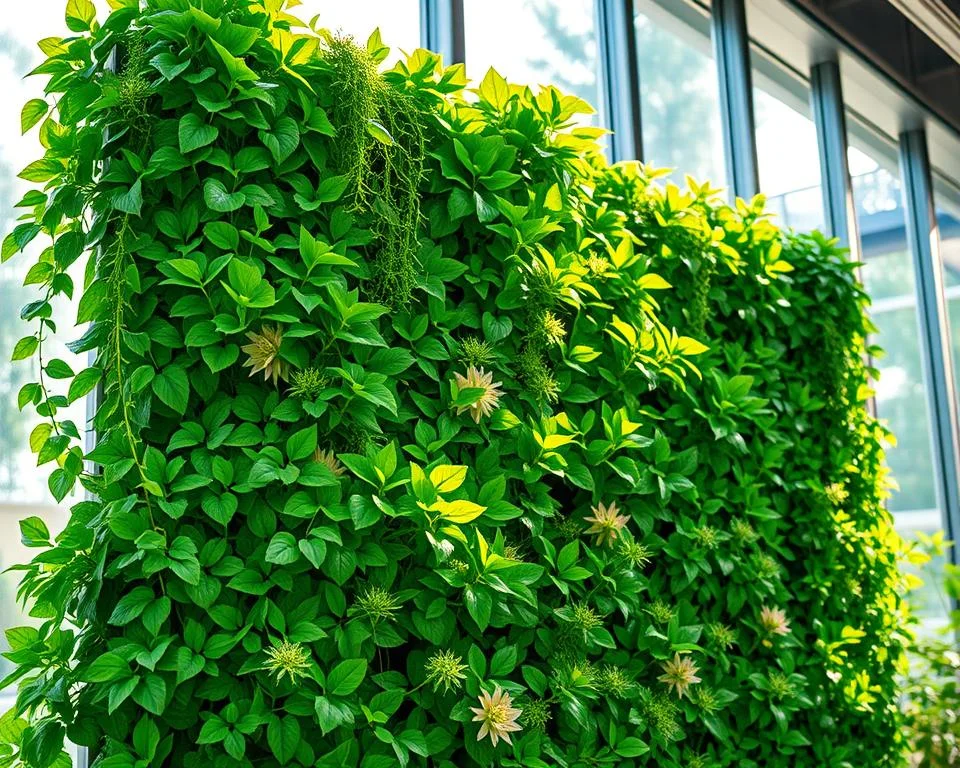
Soilless cultivation opens up exciting possibilities for growing a variety of plants in vertical hydroponic systems. Your vertical garden can become a powerhouse of fresh, nutrient-rich produce with the right plant selection.
Leafy greens are the superstars of innovation in hydroponic gardening. They thrive remarkably well in vertical setups, offering impressive yields and nutritional benefits.
- Lettuce varieties (Butterhead, Green Oak, Red Oak, Romaine)
- Spinach
- Kale
- Arugula
- Collard greens
- Herbs (Basil, Mint)
Each plant brings unique advantages to your vertical hydroponic garden. For instance, kale is packed with antioxidants, while basil offers incredible flavor for culinary enthusiasts.
| Plant | Optimal pH | Shelf Life | Health Benefits |
|---|---|---|---|
| Kale | 5.5-7.0 | 7-10 days | Cancer prevention, high antioxidants |
| Arugula | 6.0-6.5 | 5-7 days | Eye health, inflammation reduction |
| Basil | 6.0-6.5 | Up to 7 days | Anti-inflammatory properties |
Pro tip: Small fruiting plants like strawberries and compact tomato varieties can also flourish in your vertical hydroponic system, adding diversity to your garden.
“With just 1.5 acres, hydroponic vertical farming can produce up to 2.7 million servings of nutrient-rich leafy greens annually.” – Urban Agriculture Insights
Remember, successful hydroponic gardening requires understanding each plant’s specific needs in terms of pH, light, and nutrient requirements. Start with these recommended plants and watch your vertical garden thrive!
Essential Growing Conditions and Requirements
Creating the perfect environment is key for successful hydroponic gardening. Controlled environment agriculture lets you manage every aspect of plant growth. This ensures optimal conditions for the entire cultivation process.
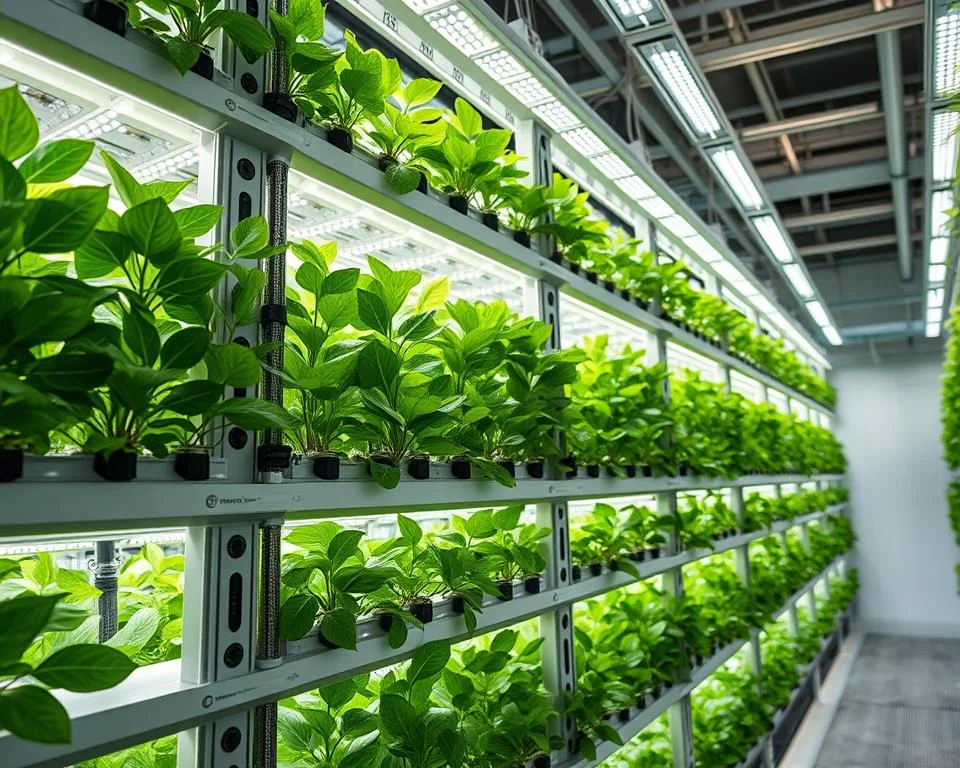
Understanding the key environmental factors is crucial. It helps you maximize your vertical garden’s potential. Let’s explore the critical elements for healthy plant development.
Illuminating Plant Growth with Grow Lights
Light is vital for plant health and productivity. Grow lights have changed indoor gardening by providing consistent, tailored illumination. Different plants need specific light spectrums and intensities to thrive.
- LED grow lights offer energy-efficient solutions
- Full-spectrum lights mimic natural sunlight
- Adjustable light intensity supports various growth stages
Mastering Temperature and Humidity
Precise climate control is essential in controlled environment agriculture. Most hydroponic plants perform best within specific temperature and humidity ranges.
“The right environmental conditions can increase plant productivity by up to 30%”
- Ideal temperature range: 65-75°F
- Recommended humidity: 50-70%
- Use climate control systems for consistent monitoring
Nutrient Solution Management
Your hydroponic system’s success depends on maintaining a balanced nutrient solution. Regular monitoring and adjustment ensure plants receive essential minerals for robust growth.
- Optimal pH range: 5.5-6.5
- Check electrical conductivity weekly
- Replenish nutrients every 1-2 weeks
By carefully managing these crucial growing conditions, you’ll create an ideal environment for your vertical hydroponic garden to flourish.
Setting Up Your Vertical Garden Structure
Setting up a vertical garden in your home needs careful planning. It can turn small spaces into places where you can grow your own food. This way, you can make the most of limited areas and grow fresh produce at home.
When designing your vertical garden, think about these important parts:
- Vertical height potential
- Weight-bearing capacity
- Light distribution
- Water circulation systems
You can build vertical garden structures in many ways. PVC pipes are a budget-friendly choice for DIY fans. Stackable hydroponic towers are another great option for indoor gardening. They help you grow plants in a compact and efficient way.
“Space is no longer a limitation when you embrace vertical farming techniques.” – Urban Gardening Expert
There are different types of vertical gardens for various indoor spaces:
- Wall-mounted panel systems
- Freestanding tower gardens
- Modular stackable planters
- Suspended growing racks
Choosing the right structure is key to your vertical garden’s success. Look for lightweight materials like food-grade plastics. They are great for creating systems that are easy to move and adapt.
Pro tip: Always ensure your vertical garden structure has robust support and proper drainage to maintain plant health.
Maintenance and Care Procedures
To keep your hydroponic vertical garden healthy, you need to pay attention every day. It’s all about keeping the nutrient solution balanced. This is key to a thriving garden.
Daily Monitoring Tasks
Every day, check on your garden to make sure it’s doing well. Important tasks include:
- Check water levels in reservoir
- Inspect plant condition for stress signals
- Verify nutrient solution pH levels
- Assess system pump functionality
- Monitor ambient temperature and humidity
Weekly Maintenance Schedule
Having a weekly plan helps keep your garden running smoothly. Here’s what to do each week:
- Clean filtration systems thoroughly
- Adjust nutrient solution concentrations
- Prune and trim plants
- Sanitize growing components
- Check electrical connections
Troubleshooting Common Problems
Even with good care, problems can still happen. Here’s how to fix common issues:
- Nutrient deficiencies: Watch for discoloration or stunted growth
- Algae development: Reduce light exposure to growing surfaces
- Equipment malfunctions: Regular inspection prevents unexpected failures
“Successful hydroponic gardening is about prevention, not just reaction.”
By following these steps, you’ll make your garden sustainable and productive. Remember, regular care means healthier plants and better harvests.
Conclusion
Hydroponic vertical gardening is changing how we grow food, making it possible in cities. It can boost crop yields by up to 50% and use 90% less water than old farming ways. This method is leading the way in making food production more sustainable.
Starting your hydroponic journey can really help. You can grow your own food in small spaces. Some vertical setups can produce 10 times more food per square foot than traditional farming. Plus, using less pesticides means healthier food for city folks.
The hydroponics market is growing fast, at 24% each year. You can join this exciting change in farming. Whether you want a small garden at home or a big community project, hydroponics offers solutions. It helps solve food security issues and uses resources wisely.
The future of farming is vertical and green, and you can be part of it. By using this new way of growing food, you help make our food system better. It will meet the needs of more people living in cities.

